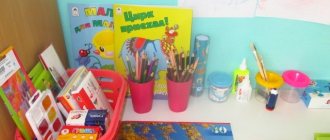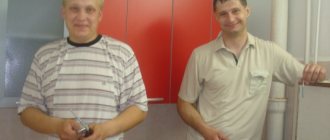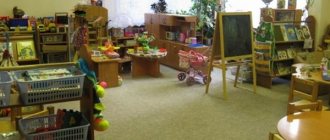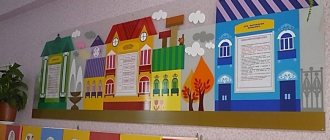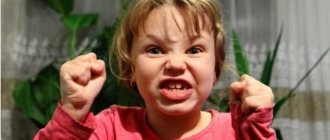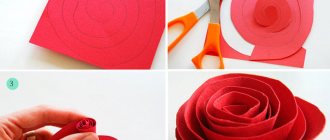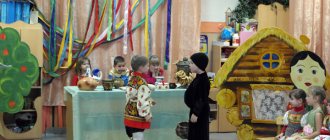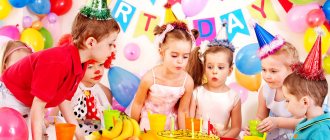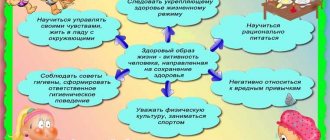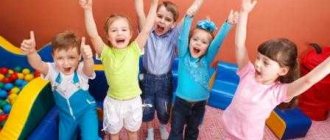The purpose and objectives of the sports ground in kindergarten
The main goal of the physical zone is to introduce preschool children to a healthy lifestyle and stop their craving for movement. This need is natural for kindergarteners, so the task of the mentor is to promote their physical education. Teach children how to properly use gym equipment in kindergarten and how to move safely in a limited area.
Objectives of the sports zone in kindergarten
The main task of a gym in a kindergarten is to organize optimal conditions for active pastime and acquiring the physical fitness desired for a particular age. The corner’s tasks also include:
- introducing children to sports;
- prevention of dysfunctions of the musculoskeletal system;
- polishing motor functions.
Below is a table that outlines the tasks of the sports zone based on the age of the children.
| Age group | Tasks |
| Junior (up to 4 years old) |
|
| Medium (4 to 5 years) |
|
| Senior (from 5 years old) |
|
| Preschool (from 6 to 7 years old) |
|
The design of the physical education area should directly resonate with its objectives for each age group. And the complete physical development of children depends on its equipping with sports equipment for kindergarten.
Center for physical activity in kindergarten according to the Federal State Educational Standard
Organization of a physical activity center in kindergarten groups.
Independent motor activity of children is an excellent means of physical and emotional development of the individual.
Let us dwell in more detail on the characteristics of the conditions for the development of movements of preschoolers in different age groups. Junior preschool age A child of two or three years old is actively exploring the world, using for this a still small reserve of movements: crawling, climbing, climbing, throwing, rolling, etc. His movements are not yet coordinated, steps when walking and running are mincing and noisy, there is no coordination in the work of his arms and legs, and with sudden movements he often falls. But how many positive emotions does the little researcher receive from satisfying the need for movement given to him by nature? The first task of the teacher is to choose the right physical education and gaming equipment. It is necessary to proceed from what basic types of movements should be developed at this age: walking and running, balance and coordination, jumping on the spot (at two years) and jumping from a height (at three years); rolling, rolling and throwing the ball; crawling, crawling under arches, climbing into a box, onto a cube, climbing over a log, climbing a stepladder, etc. In this regard, for independent motor activity of children in a group room, it is advisable to have the following set of physical education equipment and small equipment: - smooth board (length 1.5 m, width 20 cm); — gymnastic bench (length 2 m, height 15 cm, width 20 cm); - ribbed board (length 1.5 m, width 20 cm); — two arcs for climbing and rolling balls (height 50 cm, width 50 cm); - two cubes (edge 25-30 cm); — drawers for climbing in (height 20.15 and 10 cm, width and length 50, 47 and 44 cm, respectively); — stepladder (height 1.5 m); - balls (diameter 6-8 cm, 10-15 cm, 20-25 cm) - five of each size; - one or two inflatable balls (diameter 40 cm); — rolling toys (two sets of different types); - log (length 1.5 m, diameter 20 cm); — recreational and preventive path (fine gravel, footprints, fabric of different textures, massage mats, etc.); — large toys on wheels (at least four); — cord (length 10 m, diameter 10-12 mm); - rattles, rings, plumes, ribbons, flags - according to the number of children; - four gymnastic sticks (length 75-80 cm); - gymnastic pole (length 1.8-2 m). Multifunctional modular sports and play equipment - a transformer - is optimal for the development of a child’s motor sphere. The “Cubes” manual is interesting and useful for the comprehensive development of movements. The equipment must be bright, attractive, meet hygienic requirements and safety rules. The teacher is obliged to check the stability and reliability of the equipment. This is especially true for swings, slides, and ladders, which are used only with an adult’s safety net. The second task is to correctly place physical education and gaming equipment. Often, educators, in an effort to zone the playroom, place equipment in a specific safe place (in a drawer, box, on a rack, etc.). We believe that this is not entirely advisable for the following reasons. Firstly, children's behavior is involuntary and situational. Comprehending the basics of movements, they study the properties of various objects and toys that fall into the area of their attention. For example, a child will be interested in a musical hammer until he notices a rotating inflatable ball mounted on the ceiling. Having accidentally stumbled upon a box with rings, the child will try to fit into it, and when he finds the details of the pyramid here, he will try to assemble the structure. Secondly, children aged two or three always imitate their peers. Therefore, when he sees how enthusiastically another child plays with a ball or fervently runs around the group room with a rolling toy, he will definitely want to follow his example. Physical education equipment for a child is the basis for learning how to use it. Place equipment and small inventory around the perimeter of the room in safe areas, modeling the trajectory and nature of the children’s movements. Try to ensure that the child does not have difficulty finding the item he needs. The object itself should stimulate and at the same time suggest a way to perform actions with it or on it. Creating game situations (“a bear sitting on a gurney”, “a kitten stuck on the top rung of a stepladder”, “a car located under an arc-garage”, “a bunny sitting on a ribbed board”) will be a powerful incentive to repeatedly perform motor skills. actions with toys. Of course, there is no need to turn your playroom into an equipment storage area. However, it is important that the inventory fits logically into the interior of the room, and change its location once or twice a week, combining several items into a single obstacle course. Thus, in the first and second junior groups it is not advisable to create a special physical education corner. The entire room should be a single movement space in which each child can satisfy his need for movement, acting with a variety of physical education and play aids. Middle preschool age According to research, in the fifth year of life, preschoolers experience a significant increase in motor activity indicators. The child becomes more mobile and seems tireless. However, its capabilities are still small. He is poorly oriented in space and is not dexterous enough, so careful control over the intensity and content of his independent motor activity is necessary. Since physical education classes in the middle group are held in the gym, there is no need to keep all the equipment in the group room. We recommend setting up a special physical education corner for children to practice independently. The optimal place for such activities is an area away from windows, closets, and a corner of wildlife. Niches, shelves, hooks, drawers, carts and other options for placing equipment must meet hygienic and pedagogical requirements, and the equipment itself must meet the principle of expediency. For example, the Darts game should be placed at the child’s eye level, foot massagers should be placed in a niche on the floor, etc. The physical education corner should logically fit into the interior of the room, harmonizing with it in color and style. When selecting physical education equipment, it is also necessary to take into account the possibility of organizing the physical activity of children in a limited area individually and in small groups. It is advisable to place equipment that will help consolidate the motor skills acquired by children in classes. However, some of the equipment (ladders, arches, benches, etc.) are too cumbersome, and the use of other aids (gymnastic sticks, balls) is unsafe without the supervision of a teacher. It is advisable to place such equipment on the site and use it during a walk. Physical education and gaming equipment specially designed for a group room is universal - small-sized, lightweight, with a pronounced entertainment and developmental focus: - skittles (one or two sets); — game “Darts” (with Velcro balls); — rackets with balls with Velcro; — floor and hanging ring throwers; — game “Towns” (made of plastic); - foam and fabric balls; - two or three jump ropes, a cord; — plumes, ribbons, flags, plastic dumbbells (two or three sets); - two or three bags weighing 200 g; - two or three hoops; - tambourine, musical hammer; — health and preventive path (fine gravel, footprints, fabric and materials of different textures, massage mats, etc.). If in younger groups children learned the basics of movements and explored the possibilities of using each object, now they strive to perform movements in different ways, choosing the most rational one. In other words, children begin to master the correct technique of movements. Senior and preparatory preschool age A higher level of psychophysical development of a senior preschooler ensures corresponding changes in his motor activity: coordination of movements improves, motor actions become more economical, coordinated and rhythmic. Thanks to a fairly high level of orientation in space and volitional regulation, the child behaves confidently in a limited space, can slow down movement, change its direction, switch to another, which makes his activities in a group room safer. The accumulated motor experience allows children to spend their free time meaningfully, organize games with peers, and independently use a variety of equipment. In older preschool age, the child’s psychophysical qualities and motor abilities develop: speed (5 years), strength and flexibility (5-6 years), endurance (6 years), eye and coordination of movements (6.5 years). In addition, there is a difference in interests and preferences among children of different sexes. Preschoolers gravitate towards complexly coordinated motor actions and sports games, and training devices that allow them to perform a variety of movements, so the physical education corner in older groups has its own characteristics. Firstly, the corner becomes a “mirror”, which reflects the sports life of the group (competitions, family tourist gathering, etc.). For example, after a physical education festival or an Olympics, you can place a pennant, cup, and photographs of participants in a corner; after a tourist walk - children’s drawings reflecting their impressions, as well as crafts made from natural materials. Here you can also place thematic mini-collections of badges, stamps, postcards, talismans; Place board sports games (basketball, hockey, checkers, etc.) in a specially designated place (niche, folding table). Secondly, the contents of the physical education corner are replenished with sports equipment, with the help of which elements of sports games are taught. Thirdly, the simplest small-sized training devices are added to the corner. They can be replaced by homemade rubber expanders for strength exercises, elastic bands for jumping, balance beams for developing balance, etc. Fourthly, an option for equipping a corner can be a ready-made mini-stadium or a physical training complex. The apparatuses are arranged in the form of a “gymnastic tree” so that from one apparatus one can climb onto two adjacent ones. The following movements are basic for various combinations on apparatus: hanging (crossbar, rings and trapezes), jumping, rotation (waist looping), swinging (removable rocking bag, swing and vertical swing vines), rolling (indoor slide), balance ( inclined triangular ladder) and climbing (all of the above equipment). A trampoline is stretched under all the equipment or a mat is placed, which both insures and provides shock absorption during a dismount. In order for the mini-stadium to be popular, classes can be given a plot-like character. It is known that children are most attracted to performing entertaining exercises in accordance with the accepted role. They happily imitate the habits of a cat, squirrel, or monkey climbing from branch to branch. By joining in the plot proposed by the teacher or inspired by a fairy tale or cartoon, children gladly respond to the offer to climb to the top of a tree, stock up on nuts, get bananas from the top branch, etc. Shells can be decorated and diversified with homemade attributes. This will keep children interested in doing gymnastic exercises. Organizing independent classes at such a mini-stadium is possible subject to the following conditions: periodic testing of structures for strength and stability of fastenings; teaching children safe techniques for performing exercises, how to climb from apparatus to apparatus; strengthening the self-insurance technique; performing exercises in sports shoes or barefoot; provision of insurance by the teacher. Indicative list of equipment for a standard physical education corner: - game “Towns” (made of plastic); — rackets and ping-pong balls (two sets); - skittles (one or two sets); — a small basketball hoop and fabric balls; — game “Darts” (with Velcro balls); - ring throw; - one or two rubber expanders; — two “Health” disks; — mini treadmill; — track roller; - two or three jump ropes and elastic bands; - plumes, ribbons, braids; - tambourine; - two or three hoops; — board sports games; — simulators (foot, hand); — massagers (foot, hand). Older preschoolers prefer same-sex company and, accordingly, certain types of movements. Boys are more attracted to exercises aimed at developing strength, speed, agility, and accuracy; girls - to develop coordination, plasticity, flexibility, expressiveness of movements. Increasing the independent motor activity of children is considered as one of the effective means of preserving the child’s health, improving his physical fitness, enriching his motor experience, and increasing his creative and cognitive potential. References 1. Vavilova E.N. Develop agility, strength, and endurance in preschoolers. - M.: Education, 1981. 2. Glazyrina L.D. Physical education - for preschoolers. - M.: Vlados, 1999. 3. Gromova S. Subject-based physical education classes with elements of corrective gymnastics // Preschool education. - 1996.- No. 6, 8, 10. 4. Erofeeva T.I. Modern educational programs for preschool institutions. – M., 1999. 5. Lazarev M.L. Hello! Educational and methodological manual for teachers of preschool educational institutions. - M.: Mnemosyne, 2004. - 248 p. 6. Makhaneva M.D. Raising a healthy child. - M., 2000. 7. Fundamentals of safety for preschool children / Ed. V.A.Ananyeva. - M.: Academy, 2000. 8. Osokina T.I. Physical education in kindergarten. - M.: Education, 1986. 9. Runova M.A. Motor activity of a child in kindergarten: A manual for preschool teachers, teachers and students. - M.: Mozaika-Sintez, 2004. - 256 p. 10. Stasyuk A.M., Zhuravleva N.A. About the system of physical culture and health work // Preschool education. – 1997. – No. 9. — P.39-42. 11. Sukharev A.G. Health and physical education of children and adolescents. - M.: Medicine, 1991. - 272 p. 12. Fedorovskaya O.M. Physical education, health and preventive work in preschool educational institutions // Preschool education. – 2004. – No. 1. – P. 33-36. 13. Khukhlaeva D.V. Methods of physical education in preschool institutions. - M.: Education, 1984. 14. Khukhlaeva D.V. Theory and methods of physical development of preschool children. – M.: Education, 1976. 15. Shebeko V.N. Physical education of preschool children. – M.: Academy, 1996
We recommend watching:
Program for kindergarten in physical education of a preschool educational institution, Junior - middle group Work program for physical education in a preschool educational institution, taking into account the Federal State Educational Standard. Senior - preparatory group Organization of physical activity of children during a walk in a preschool educational institution Independent motor activity in kindergarten
Similar articles:
The role of folklore in the physical education of preschool children
Morning exercises in the second junior group in a playful way
Morning exercises in kindergarten in the preparatory group
Requirements for the design of a sports corner in a kindergarten
When developing the layout of a sports ground, you need to remember that children of preschool age will be playing on it. Therefore, the corner for sports equipment must comply with the following rules:
- Safety The sports corner should be located in a safe place, away from fragile, sharp or heavy objects. Sports equipment should also be environmentally friendly and safe.
- Optimal placement It is better to divide the gym into zones according to the physical elements. This will help save a lot of space. And sports equipment should be placed so that it does not interfere with the motor activity of children. The corner in the group should be located next to the play area and the place of theatrical activities.
- Ease of use All equipment for exercises and games should be freely accessible, based on the age of the children, their gender and interests.
- Aesthetic design The physical development center in the garden should be aesthetically designed. It would be better if it was bright sports equipment. This design will attract attention and encourage action. It would be ideal to design the physical education area in the same style as other development sectors of the group.
- Testing All equipment must be subject to a load test and visual inspection.
Important! When developing a project for a sports complex for a kindergarten, you need to pay attention to its size. According to standards, each child must have at least one square meter of space.
Even more information about the requirements and design features of a sports zone in the following video:
Group exercise corner
Authors:
Myakisheva Lyubov Vladimirovna – teacher of the highest category
Tsvetkova Anastasia Andreevna - teacher
MADOOU CRR - kindergarten No. 177 in the city of Tyumen
“Children are exactly the same as adults
I want to be healthy and strong,
Only children don’t know what to do for this.”
Janusz Korczak
The goal of our preschool educational institution is to create favorable conditions for the formation of a successful personality of a preschooler, the preservation and strengthening of health, and the comprehensive development of physical qualities.
We promote the development of initiative and independence in children's daily physical activity. Motor activity is the basis of a child’s individual development and life support. Movement is a means of understanding the world around us, satisfying biological needs on which children’s health, their physical and general development depend.
In accordance with the Federal State Educational Standard, a preschool educational institution graduate must have good health, good physical development, and physical fitness.
In order for children to move actively, adults must create favorable conditions. The motor environment should be saturated with various equipment and sports equipment. Our group has a physical training room. Our physical education corner has a wide variety of sports equipment: health tracks, tags, dominoes, checkers, ring throws, hummocks, golf, skittles, gymnastic sticks, balls and much more.
The physical education corner should be maximally adapted to meet the children’s need for movement. The following requirements are imposed on the physical education corner and its equipment: pedagogical, aesthetic, hygienic. With the help of the physical education corner, the independent motor activity of children develops well.
Children enjoy using sports equipment in their daily life at the kindergarten.
The kids love to take part in various relay races, for example, using ring throw. Children develop interest in sports, development of accuracy, dexterity of movement, and orientation in space.
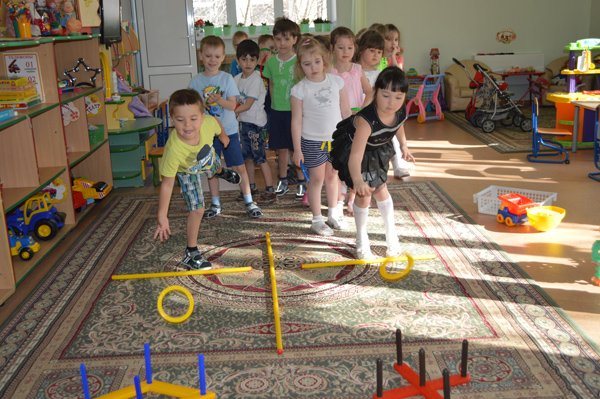
Children also enjoy relay races involving climbing and jumping over obstacles.
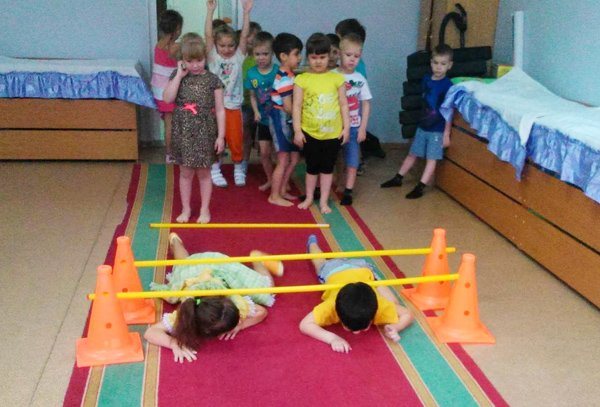
For this we use gymnastic sticks and cones . Physical qualities such as flexibility, endurance, intelligence, speed and clarity of movement develop. Children become more interested in the game, their mood rises, and they feel like one with the team.
Physical education equipment “bumps” can also be used in relay races, when running with obstacles, taking a ball in your hands and passing it to each other.
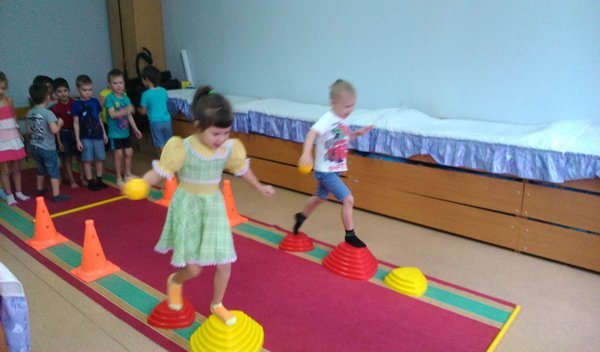
Also, to improve movements, develop speed, endurance, and coordination of movements, children love outdoor games. In the formation of a child’s diversified personality, outdoor games are given the most important place. They are considered as the main means and method of physical education. Being an important means of physical education, outdoor play simultaneously has a healing effect on the child’s body.
For example, such as “traps”, where they use multi-colored ribbons. Children play in a team, navigate the current situation, develop qualities such as will, desire to win, strength, dexterity and speed of reaction.
Active physical activity, in addition to its positive impact on health and physical development, provides psycho-emotional comfort for the child. For example: rolling a ball to each other during the verbal-logical game “I know 5 names...”.
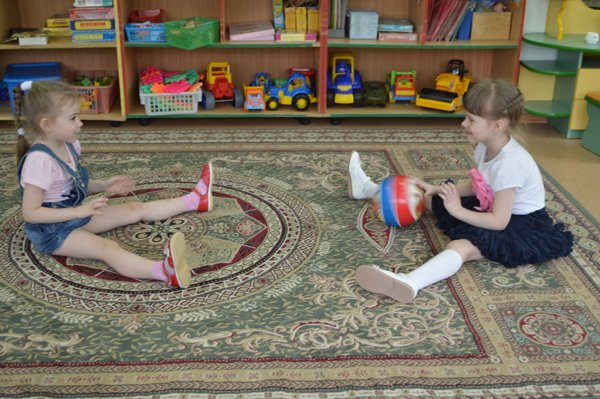
A large number of movements activates breathing, blood circulation and metabolic processes. This in turn has a beneficial effect on mental activity. Articulation gymnastics is carried out using non-traditional sports equipment.
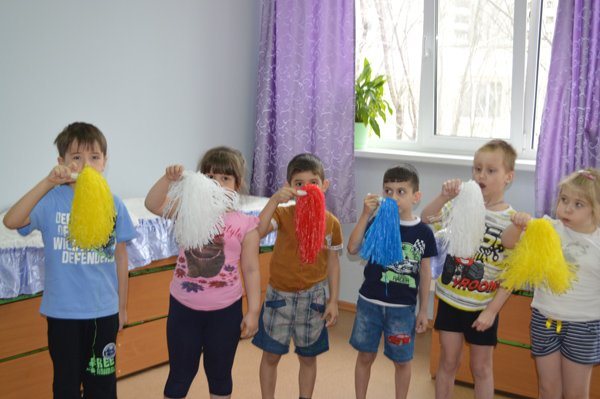
The game of golf cannot be played without a club and a ball. With the help of this game, children develop their eye and accuracy of movement.
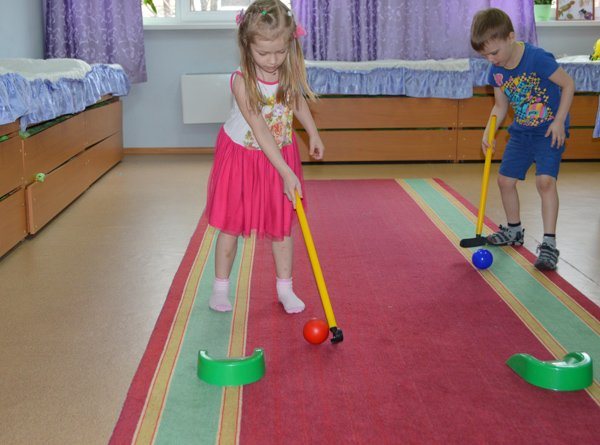
Tag is a game that develops children's thinking, concentration, intellectual abilities, ability to work in a team, joint decision-making, and develops counting.
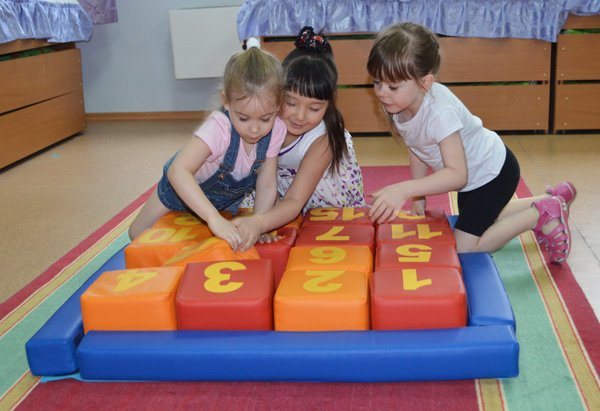
Checkers develop logical thinking.
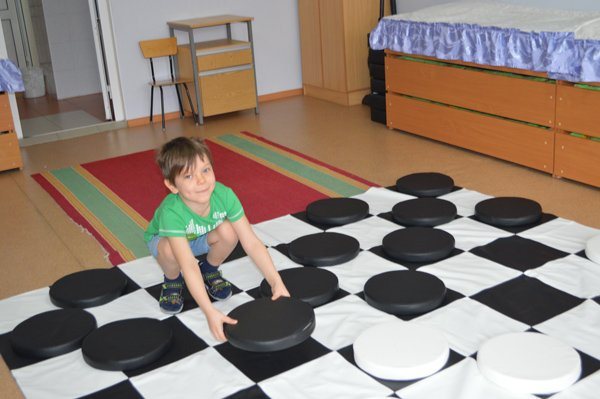
Dominoes teach children the ability to play together and obey the rules of the game.
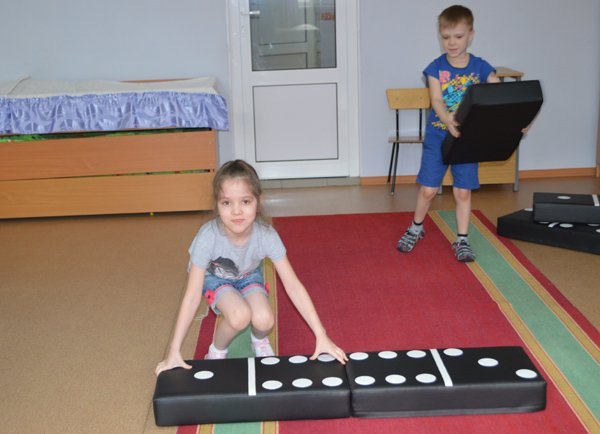
To prevent flat feet and provide various effects on children’s feet, health tracks are used. Regular massage of the feet helps to improve the child’s health daily and easily.
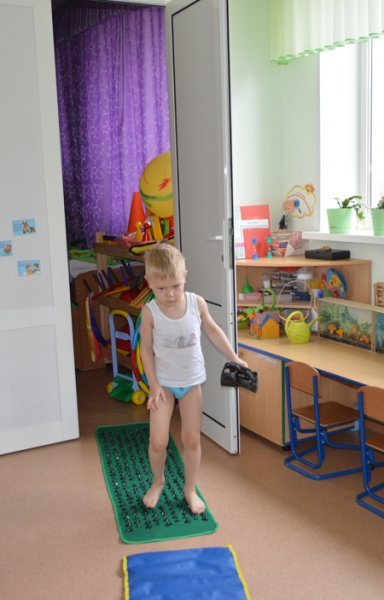
The health track allows you to make this process not only useful, but also very exciting. For example, using bags for balance and coordination of movement.
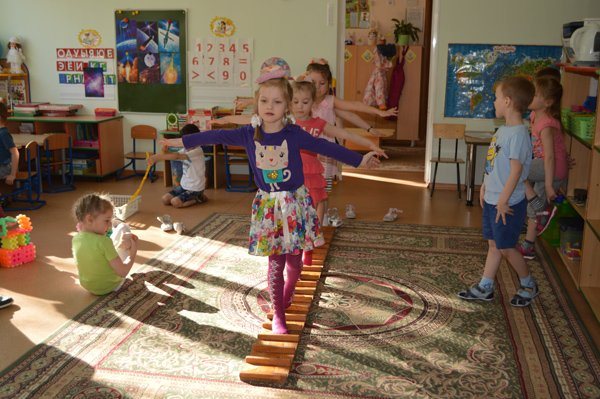
Thus, the creation of a developmental environment for independent motor activity of children, adequate to their age and needs, helps to improve health, expand motor experience, develop a strong interest in physical exercise, self-organization skills and communication with peers.
We invite teachers of preschool education in the Tyumen region, Yamal-Nenets Autonomous Okrug and Khanty-Mansi Autonomous Okrug-Yugra to publish their teaching materials: - Pedagogical experience, original programs, teaching aids, presentations for classes, electronic games; — Personally developed notes and scenarios of educational activities, projects, master classes (including videos), forms of work with families and teachers.
Why is it profitable to publish with us?
1. “Kindergartens of the Tyumen Region” is an officially registered specialized media outlet at the federal level. 2. The activities of the editorial office are supported by the Department of Education and Science of the Tyumen Region 3. We issue a “Certificate of Publication” in the media. 4. The document has a unique number, is entered in the register, has the original seal of the editorial office of the online publication and signature. 5. “Certificate of publication” in the media is sent to the author in both paper and electronic versions.
Details >>>
Sample “Certificate of publication of author’s methodological material in the media.”pdf
Share
Equipment for the physical training area
To ensure that preschool children’s sports activities are as active and useful as possible, you need to properly distribute the equipment. Convenient placement of sports equipment allows children to easily approach them without interfering with each other.
Important! To maintain interest among kindergarteners, you can periodically change the location of the equipment.
Modern equipment for a sports ground may contain the following list of sports furniture and equipment:
- Swedish wall;
- gymnastic benches;
- rope ladder; rope ladder and other attachments;
- a special place for storing equipment - jump ropes, hoops, balls, relay batons, etc.;
- soft modules and trampolines;
- plastic slide;
- dry pool;
- orthopedic rugs and tracks;
- gymnastic mats;
- regular and massage balls, rings and rollers, jump ropes and sandbags and other small dispensing equipment;
- football goals and so on.
All this equipment should be used taking into account the age group of children. For example, if a dry pool is suitable for children, then soft modules are suitable for older kindergarteners. As the children's interests expand, the corner can be replenished with more complex equipment.
Brief description of the main sports equipment
The main characteristics of gym equipment are shown in the table.
| Equipment | Characteristic |
| Swedish wall | Typically, sections are located around the perimeter of the entire gym. Their optimal number is from 4 to 6. The height of the sections should be no more than 2.5 meters, and the distance between the crossbars should be from 20-22 and 30-40 cm. It’s good if the wall is equipped with additional equipment - a rope ladder, trapeze, rope, rings, etc. It is imperative to place a gymnastic mat near the wall bars. |
| Benches | Benches should be smooth, without cracks or snags. They should also not be slippery. The height of the benches can be 20, 25,30 cm, and the length is 3 meters. |
| Soft modules, trampoline, mats | Choose equipment with good padding to avoid injuries. Stick to models in bright colors. The modules can be used as building material, arches and obstacles. |
| Orthopedic mats and tracks | Important elements for preventing flat feet and training your feet. The path may contain small parts, hard and soft elements. |
Features of equipment for the younger group
For kids, it is better to design the corner as one of the parts of a large play area. Rolling toys, balls of different sizes, cubes, tambourines, and walking slides should prevail here. Children, being in constant motion, must use the available equipment and toys at their own discretion.
Of great interest to younger preschoolers are masks for games, presented in the form of fairy-tale characters. They can be successfully used in sports exercises and games.
The video shows an example of the design of a physical education area for children:
How best to decorate a corner in the middle group
Supplement the physical education area with albums on introducing different sports. Sports equipment here is formed based on subgroups of children who already organize their own sports leisure activities. Games such as darts, skittles, and towns should be freely available. Details about the design of a corner for children under 5 years old are shown in the video:
What to pay attention to when designing a sports corner in the senior group
For older kindergarteners, it is reasonable to create a complex atmosphere for performing different types of physical education elements. It is also important to introduce children to key episodes in the sporting life of the country and city. In addition to a variety of sports equipment, the corner in the senior group should be supplemented with schemes for conducting different games, according to which the children themselves will be able to play any game. The sports area should be actively used during the day, both together with the teacher and individually. An excellent addition to the physical education area for the older group will be a Swedish wall with rings and a rope. What else can be equipped with a sports corner in a kindergarten, see the video:
